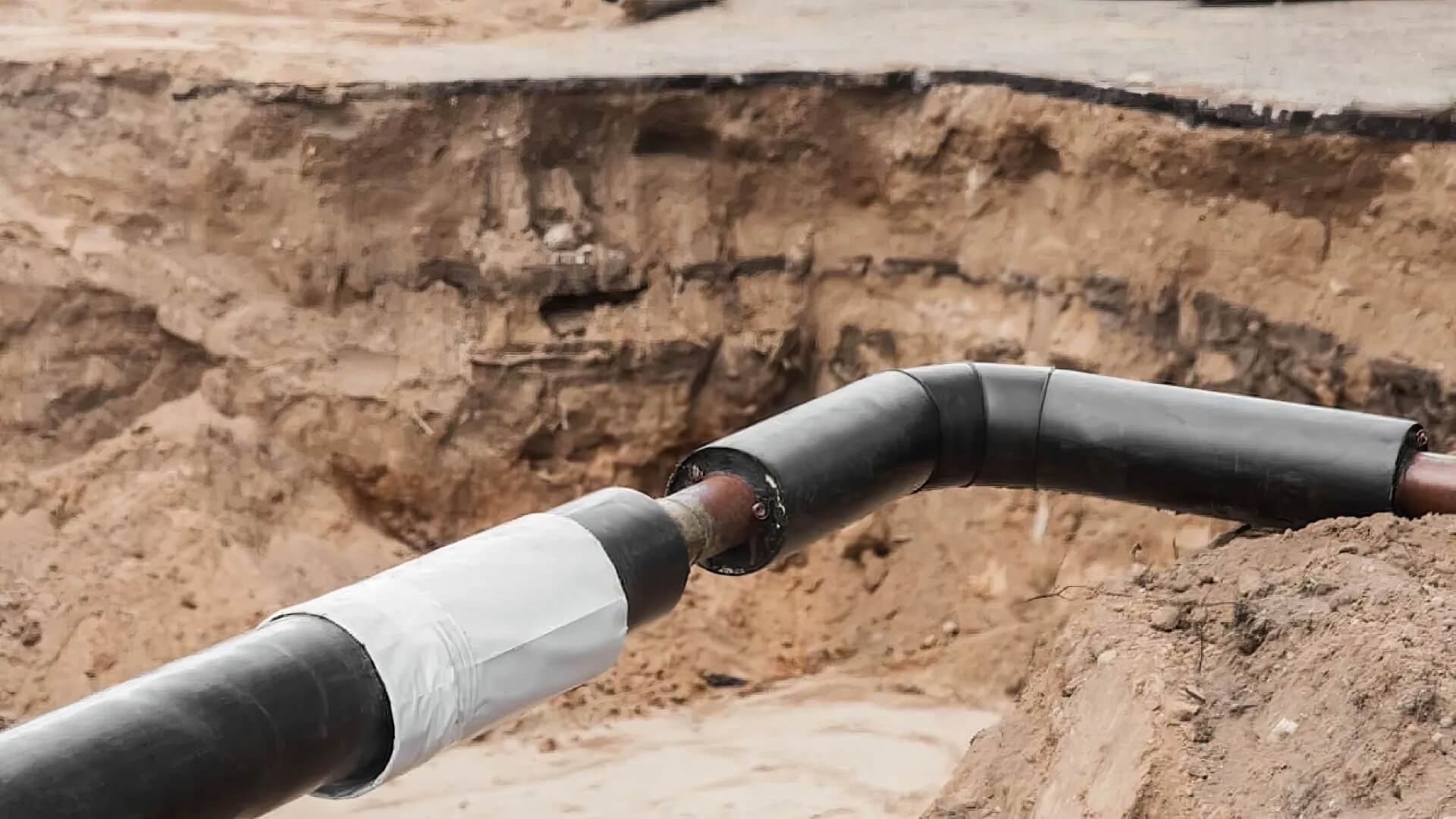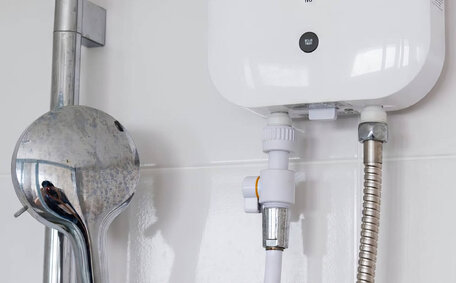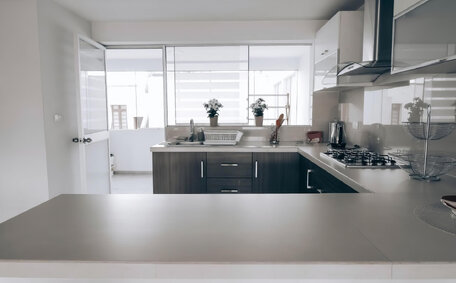Checking Basic Issues First
When your hot water system stops working abruptly, it may initially be daunting. However, there are some basic checks you should do first before panicking. Determining whether the issue is isolated or systemic simplifies troubleshooting.
Determine if the issue is localized to a single tap or affects all hot water outlets in your property.
Oftentimes, you can resolve common hot water problems on your own, potentially avoiding the expense of professional assistance.
Ensure Water Supply is On
One of the easiest things to check when you lose hot water is whether the main water supply feeding your home is turned on.
Every property has a master water service shutoff valve, which controls the hot water heater supply, usually found where the main water line enters the house. Make sure this valve is not turned off and is fully open. It’s possible someone accidentally bumped it or didn’t open it all the way after doing some plumbing repairs.
Confirm this by activating multiple cold water faucets. If no water emerges, this signals that the main supply may be shut off. Locate the main valve and turn the handle so it’s perpendicular to the pipe to restore full water pressure.
Once the supply valve is confirmed to be open, also test a hot water tap. If you now get cold water but still no hot, the issue likely lies with your hot water system or heater rather than your home’s water line.
Check Circuit Breakers and Fuses
First, find the main electrical service panel, which you’ll typically find in the garage, laundry room, or basement.
Reset tripped breakers by switching them all the way to off, then back on. Replace blown screw-in fuses with ones of the same amperage rating. Be extremely careful when working in the electrical panel.
If the home’s water and power supplies are fine but hot water remains absent, the issue likely stems from your circuit or the hot water unit itself. Refer to the previous section’s overview on resetting electrical supply as an important troubleshooting step.
Troubleshooting Your Water Heater
The first step in troubleshooting a lack of hot water is identifying whether you have a gas or electric water heater. This determines the correct course of action:
Gas Water Heaters
- Confirm the pilot light is on, and follow the manufacturer’s instructions for safely re-igniting it if necessary.
- Inspect the gas supply line and valves for any potential gas leaks, using a spray bottle of soapy water to test connections.
- Make sure the gas shutoff valve is fully open and supplying fuel to the water heater.
- If heat production is insufficient, the thermocouple sensor might require replacement.
Electric Water Heaters
- Reset the home’s circuit breaker if tripped and verify power is running to the unit.
- Examine the heating elements and thermostats - they may need replacing.
- Check that the temperature/pressure relief valve isn’t dripping, indicating a failing tank.
If you’ve confirmed all basic functions and your gas hot water system still fails to heat water, professional servicing is required. Maintain thorough records to share with the technician.
Electric Water Heater Troubleshooting
When troubleshooting electric hot water systems, there are a few key areas to check before calling a professional.
Verify Power Supply
Check that electricity is running to the water heater by testing the outlet with a multimeter or plugging in a lamp. Reset any circuit breakers connected to the unit that have tripped.
Reset Water Heater
Many electric heaters have a reset button that pops out when overheating occurs. Push this button back in to check if it reactivates the system. Allow the unit 10-15 minutes to heat up the water.
Check Cutoff Switches
Your hot water system’s high-temperature cutoff switches near the top prevent dangerous overheating. If tripped, these must be manually reset by pressing the red button back in. There may be multiple switches.
Heating Element/Thermostat
Heating elements located at the tank’s base warm up the water. The thermostat controls this temperature. If not heating, the element or thermostat likely needs professional replacement.
Gas Water Heater Troubleshooting
For troubleshooting gas water heaters, make sure to check:
Pilot Light
Ensure the pilot light is ignited and consult the manufacturer’s guide for safe relighting procedures. If the thermocouple sensor is faulty, it should be replaced.
Gas Supply
Inspect along the gas line and valves for leaks using a spray bottle of soapy water. Check that all connections are secure and bubble-free. Make sure the supply valve is open and providing ample fuel.
Valves & Sensors
If the pilot light is on but there’s no hot water, the inlet or main gas valve might be jammed closed. Thermocouples, pressure relief valves, and inlet valves might require replacement if they are malfunctioning.
Should gas water heater issues persist, engage a licensed technician for servicing and maintain detailed notes on actions taken.
General Water Heater Issues
Beyond gas or electric-specific troubleshooting, there are some general water heater problems to watch out for:
Discoloured Water
Discoloured water from hot taps suggests compromised tank linings or sediment accumulation, necessitating a system flush.
Strange Noises
Audible clanking, rumbling, or cracking noises warrant professional attention, as they can indicate severe problems.
Low Water Pressure
Inadequate pressure at all sinks likely indicates a problem with your homes plumbing, not the hot water unit specifically.
Identifying these early warning signs reduces the risk of catastrophic failure and helps diagnosis for repair technicians. Keep detailed records of ongoing issues to share.
Low Water Pressure and Leaks
There are a few common causes of low water pressure throughout your home’s plumbing:
Partial Blockages
Buildup of sediment, rust, or minerals can slowly restrict water flow through the hot water system’s pipes and fittings. This reduces pressure.
Failing Water Pump
If your building relies on a pump system to supply pressurised water, a malfunctioning pump can cause inadequate water pressure.
Water Leaks
Leaks anywhere in the hot water line, at pipe joints, or in the heater tank itself can drastically lower water pressure. Visually inspect for any water puddles or drips. Some leaks may not be visible.
Persisting low water pressure, accompanied by other issues, indicates professional servicing is needed. A plumber can fix leaks and restore full water pressure.
Sediment Buildup
Over months and years of operation, sediment residue and mineral deposits can gradually accumulate inside the tank and pipes of your hot water system. This buildup of rust, scale, and other debris will eventually hinder heating efficiency, reduce water flow, and may even damage heating elements.
To prevent declining performance, it’s recommended to periodically flush and de-scale electric water heaters and de-sludge your tank if you have a gas water heater. Draining a few gallons from your water tank helps clear sediment and extend the lifespan of your system.
Gas water heaters may also develop a “sulphur smell” from sediment buildup, requiring draining. Consult your manufacturer’s maintenance guidelines on when to drain and flush your specific model.
Ignoring sediment deposits leads to reduced heating efficiency and higher energy costs. A licenced plumber can professionally clean or replace tanks if DIY flushing proves inadequate.
Faulty Thermostat
An inconsistent water temperature or fluctuating heat is one of the key indicators of a faulty thermostat in your hot water system. Thermostats regulate the water temperature by communicating with the heating mechanism to turn on or off as needed.
To check if your thermostat is working correctly:
- Turn on a hot water tap and measure the initial temperature using a digital thermometer.
- Allow the water to run for a few minutes then test again. Temperatures should remain steady.
- Compare temperatures from different taps. They should all align to the thermostat setting.
If temperatures fluctuate significantly, get your hot water thermostat adjusted or replaced to maintain consistent heat. Attempting to replace a thermostat carries the risk of electric shock or burns if power isn’t disconnected properly - have a licenced technician service it.
A faulty thermostat is not only wasteful in terms of energy but also poses a scalding hazard, underscoring the importance of a dependable hot water supply. Refer to the earlier section on temperature controls for more on addressing common thermostat issues.
When to Call a Professional
At a certain stage in troubleshooting, expert intervention may be essential as DIY remedies prove insufficient. If you’ve methodically tried the previous tips yet still have no hot water, it’s time to call a professional.
Interfering with sophisticated electrical or gas systems risks electrocution, fires, flooding, or even explosions. Instead of guessing, it is prudent to engage a licensed plumber for diagnosis and repair of the water heater.
For residents in Western Sydney, your local Erskine Park Plumbing boasts over 25 years of expertise in servicing hot water heaters. If your troubleshooting fails to restore hot water, give us a call on 1300 349 338 or email jobs@erskineparkplumbingservices.com.au to schedule an appointment.
Technicians can assess if your gas-electric heater needs new heating elements, thermostats, pressure relief valves, or pipe replacements. They possess all the tools and qualifications necessary to safely undertake installations and repairs.
Contact a professional at the onset of issues to avert a major breakdown that could leave you without any hot water.
Regular Maintenance and Prevention
Performing routine maintenance checks and securing preventative servicing for your new hot water system is crucial to avoid disruptive breakdowns and ensure maximum lifespan.
Simple tasks homeowners can regularly do include:
- Regularly visually inspect pipes and valves to check for leaks or corrosion
- Monitor water pressure at taps - declining pressure may indicate blocked drains or other issues
- Check for unusual noises like rumbling or cracking
- Test water temperature consistency
- Drain sediment/flush tanks annually as per manufacturer guidelines
An expert inspection and tune-up by a licenced technician every 1-2 years picks up problems before failure. They will:
- Thoroughly inspect all components like heating elements, thermostats, and pressure valves
- Descale electric tank interiors and clear sediment in gas heaters
- Confirm proper temperature/pressure settings
- Test for gas/exhaust leaks with detection equipment
- Verify safety mechanisms function correctly
Erskine Park Plumbing offers reliable maintenance plans to keep your hot water flowing smoothly all year. Email jobs@erskineparkplumbingservices.com.au or call 1300 349 338 to schedule annual servicing.






